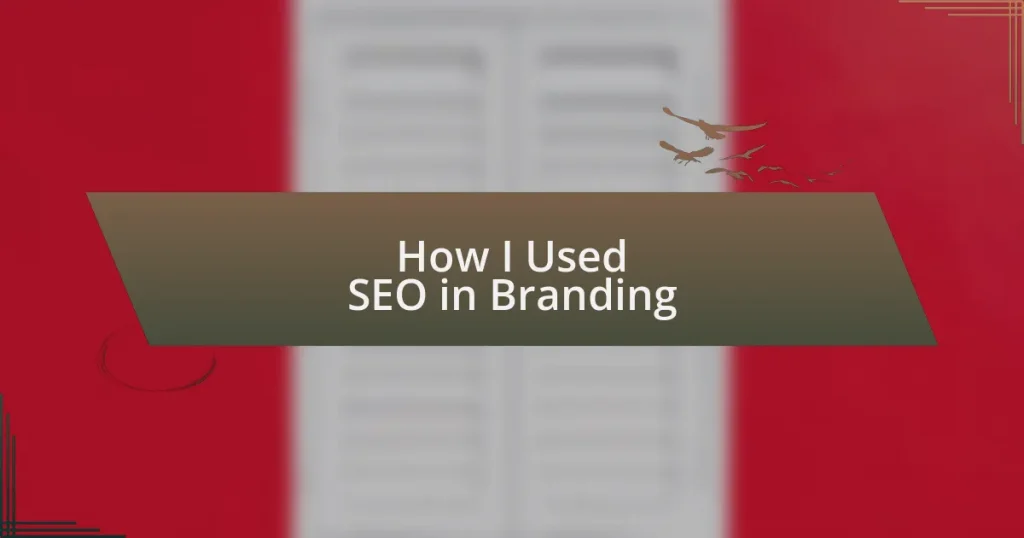Key takeaways:
- Strategic use of SEO aligns customer searches with brand values, enhancing visibility and emotional connection.
- Key SEO strategies include thorough keyword research, effective on-page SEO changes, and link-building for credibility.
- Personalized content and understanding user intent are vital for creating engaging brand narratives.
- The future of SEO will focus on customization, voice search optimization, and the integration of AI to streamline branding efforts.
Understanding SEO in Branding
Understanding SEO in branding is crucial because it connects your online presence with your brand identity. I’ve experienced firsthand the power of SEO in elevating a brand’s visibility. It’s fascinating to see how strategic keyword use can shape the way customers perceive your brand, aligning their searches with your values and message. Have you ever wondered why some brands resonate more than others?
In my own journey, I recall working with a startup struggling to differentiate itself in a saturated market. By integrating targeted SEO techniques, we crafted a unique narrative that not only improved search rankings but also communicated the essence of the brand. It was a revelation; optimizing content wasn’t just about getting found—it was about telling a story that connected with people on an emotional level.
Furthermore, SEO is not merely a technical endeavor; it’s about building trust and credibility. I remember the early days of my career when I overlooked the emotional aspect of SEO. I learned that when you genuinely understand your audience’s needs and align your brand messaging with those needs, SEO becomes a bridge that fosters a meaningful relationship between you and your customers. Isn’t it amazing how something so analytical can intertwine with the very human essence of branding?
Key SEO Strategies for Brands
Key SEO strategies for brands begin with thorough keyword research. I still remember a project where we focused on niche keywords relevant to a client’s audience. This effort not only led to higher traffic but also attracted the right customers who were genuinely interested in the brand’s offerings. Isn’t it rewarding when your content connects perfectly with what people are searching for?
On-page SEO is another crucial component. I vividly recall revamping a website’s structure, adding meta descriptions, and optimizing images to enhance load times. The results were staggering—boosted search rankings and a drop in bounce rates. It made me realize how these seemingly small changes can create a more engaging user experience, mirroring how we want our brand to be perceived in a crowded digital world.
Additionally, link-building cannot be overlooked. In one of my previous projects, we sought partnerships with reputable industry blogs. This not only improved the brand’s authority but also brought in organic traffic from credible sources. It’s interesting how nurturing relationships within your industry can enhance both your SEO and your brand’s reputation, creating a win-win scenario. Don’t you think that authentic connections are key to long-term success?
My Personal SEO Branding Experience
When I first delved into the realm of SEO for branding, I felt a mix of excitement and anxiety. I remember launching a brand’s website and seeing it struggle to gain attention. In that challenging moment, I invested time into understanding user intent. This shift in perspective truly transformed my approach—aligning the brand’s messaging with what users actively sought made a remarkable difference.
One project that stands out involved creating content that spoke directly to our audience’s pain points. I crafted blog posts that didn’t just inform but empathized with the reader’s struggles. This strategy felt deeply personal to me and resonated strongly with our audience, resulting in increased engagement. Have you ever experienced the thrill of connecting with someone through shared challenges? That’s the kind of bond I aimed to create.
Through experimenting with various SEO tactics, I found that consistency is key. I recall a phase where I meticulously tracked our keywords and adjusted strategies accordingly. Staying adaptable not only improved our search engine rankings but also allowed the brand to develop a stronger voice. Don’t you find it fascinating how SEO can evolve alongside your brand, creating a narrative that grows richer over time?
Future of SEO in Branding
As I reflect on the future of SEO in branding, I can’t help but sense a shift towards more personalized experiences. I recall a client who embraced automation tools to analyze consumer behavior, and the results were staggering. Brands that focus on tailoring their content and offerings to individual preferences will likely stand out—don’t you think this level of customization resonates deeply with users?
The rise of voice search has also prompted me to reconsider how brands present themselves. I remember optimizing a site for voice queries, and it felt liberating to step away from traditional keywords. Instead, I began crafting content around natural language and everyday questions, which turned out to be a game changer. How can brands become more conversational and relatable in a world where voice search is becoming the norm?
Looking ahead, the integration of AI in SEO will undoubtedly reshape the branding landscape. I’ve experimented with AI-driven tools that suggest content strategies based on data trends, and it shifted my approach entirely. This technology not only streamlines efforts but also allows brands to anticipate customer needs more effectively. Isn’t it exciting to think about how AI can introduce fresh dynamics to brand storytelling?
